|
|
|
Sort Order |
|
|
|
Items / Page
|
|
|
|
|
|
|
| Srl | Item |
| 1 |
ID:
141461
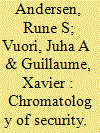

|
|
|
|
|
| Summary/Abstract |
The agenda of this article is to highlight how security becomes intelligible, is enacted, contested and (re)appropriated in part through colour use. Even though colours are a natural phenomenon, their meanings are societal products, and part of our constructed visibilities. These can be investigated through chromatology, the study of colour in relation to people. We illustrate this by applying multimodal social semiotics to view highly securitized sites, those of concentration and enemy-combatant camps. We show that the colour uses instituted to classify and govern prisoners not only structure the inmates socially, but also become vehicles for resisting the security discourses associated with them. The aim of the article is to highlight how security and international relations are intersemiotic relations, and to open up the study of security to an expanded range of semiotic modalities and methods of inquiry.
|
|
|
|
|
|
|
|
|
|
|
|
|
|
|
|
| 2 |
ID:
141780
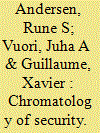

|
|
|
|
|
| Summary/Abstract |
The agenda of this article is to highlight how security becomes intelligible, is enacted, contested and (re)appropriated in part through colour use. Even though colours are a natural phenomenon, their meanings are societal products, and part of our constructed visibilities. These can be investigated through chromatology, the study of colour in relation to people. We illustrate this by applying multimodal social semiotics to view highly securitized sites, those of concentration and enemy-combatant camps. We show that the colour uses instituted to classify and govern prisoners not only structure the inmates socially, but also become vehicles for resisting the security discourses associated with them. The aim of the article is to highlight how security and international relations are intersemiotic relations, and to open up the study of security to an expanded range of semiotic modalities and methods of inquiry.
|
|
|
|
|
|
|
|
|
|
|
|
|
|
|
|
| 3 |
ID:
141779
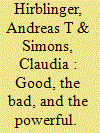

|
|
|
|
|
| Summary/Abstract |
This article argues for a reflexive perspective on the ‘local’ in peacebuilding. While it is now widely acknowledged that anything local is complex, unstable, and relational, scholars continue to make truth claims about local actors and practices. This leads to an incomplete account of peacebuilding, as it conceals the powerful effects of representation, which shape our perspective on the local. We argue that the local is both used and produced through practices of representation, and that these representations serve to define what good peacebuilding entails. We consequently suggest a perspective on perspectives, which focuses on how representations of the local relate to political agendas in peacebuilding, and which can account for the effects of choosing one mode of representation over another. Through case studies from Burundi and South Sudan, we show that representations of the local are conflictingly produced by scholars, practitioners, and government officials, telling about the true, the good, and the bad local, empowering some and disempowering other actors, institutions, and practices. These dynamics have tangible effects on peace, conflict, and (in)security.
|
|
|
|
|
|
|
|
|
|
|
|
|
|
|
|
| 4 |
ID:
141460
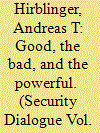

|
|
|
|
|
| Summary/Abstract |
This article argues for a reflexive perspective on the ‘local’ in peacebuilding. While it is now widely acknowledged that anything local is complex, unstable, and relational, scholars continue to make truth claims about local actors and practices. This leads to an incomplete account of peacebuilding, as it conceals the powerful effects of representation, which shape our perspective on the local. We argue that the local is both used and produced through practices of representation, and that these representations serve to define what good peacebuilding entails. We consequently suggest a perspective on perspectives, which focuses on how representations of the local relate to political agendas in peacebuilding, and which can account for the effects of choosing one mode of representation over another. Through case studies from Burundi and South Sudan, we show that representations of the local are conflictingly produced by scholars, practitioners, and government officials, telling about the true, the good, and the bad local, empowering some and disempowering other actors, institutions, and practices. These dynamics have tangible effects on peace, conflict, and (in)security.
|
|
|
|
|
|
|
|
|
|
|
|
|
|
|
|
| 5 |
ID:
157922
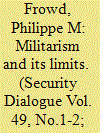

|
|
|
|
|
| Summary/Abstract |
This article assesses the concepts of militarism and militarization in relation to contemporary security interventions in the Sahel, a region increasingly understood through the prisms of violence, cross-border illicit flows, and limited statehood. This region is subject to security interventions that include French military action, EU-funded projects to prevent drug trafficking, and both bilateral and multilateral efforts against irregular migration. To many observers, it is experiencing an ongoing militarization. We argue that while the inextricable concepts of militarism and militarization go some way towards explaining interventions’ occasional use of military violence, they are limited in their grasp of the non-martial and symbolic violence in security practices. We instead propose a focus on assemblages of (in)security to show the heterogeneous mix of global and local actors, and often contradictory rationalities and practices that shape the logics of symbolic and martial violence in the region. Throughout, the article draws on the authors’ fieldwork in Mauritania, Senegal, and Niger, and includes two case studies on efforts against the Sahel’s ‘crime–terror nexus’ and to control irregular migration through the region. The article’s contribution is to better situate debates about militarism and militarization in relation to (in)security and to provide a more granular understanding of the Sahel’s security politics.
|
|
|
|
|
|
|
|
|
|
|
|
|
|
|
|
|
|
|
|
|